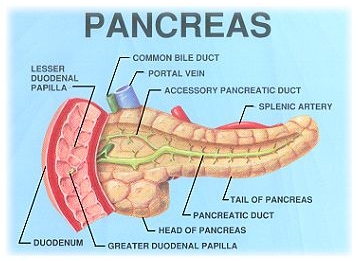
Pancreas: structure, hormones and functions
- Mixed gland (both endocrine and exocrine function)
Structure:
- Pancreas is elongated 12-15 cm long organ consisting of head, body and tail. It is located posterior to stomach with its head in the curve of duodenum. The body and tail extends laterally. The tail touches the spleen.
- pancreas is considered as mixed gland as it acts as exocrine and endocrine gland.
- As exocrine gland, pancreas secretes digestive enzymes into pancreatic duct.
- As endocrine gland,it secretes hormones into blood.
- Only about 1% of total weight of gland acts as endocrine gland. This portion of pancreas is known as Islet of Langerhans.
- Adult pancreas contsins 200,000-20,00,000 islet of Langerhans.
Endocrine portion of pancreas is called Islet of Langerhans, which is a group of cells.
- Alpha cell= produce glucagon. Glucagon plays an important role in blood glucose regulation; low blood glucose levels stimulate its release.
- Beta cell= produce Insulin. Elevated blood glucose levels stimulate the release of insulin.
- Delta cell= produce peptide hormone Somatostatin. Pancreatic somatostatin inhibits the release of both glucagon and insulin.
- * somatostatin is also released by the hypothalamus (as GHIH), and the stomach and intestines
- F cell (PP cell)= produce pancreatic polypeptide hormone.
Hormones of pancreas
1. Glucagon
- Alpha cells produce, stores and secretes glucagon.
- Glucagon stimulate glycogenolysis and gluconeogenesis; increase blood glucose level
2. Insulin
- Beta cell produce, store and secretes insulin.
- Insulin stimulate glycogenesis; decrease blood glucose level and Store glucose in the form of glycogen in liver and muscles
- Insulin function opposite to glucagon and work to maintain normal glucose level in blood.
disorders
i. Diabetes mellitus: condition caused by destruction or dysfunction of the beta cells of the pancreas or cellular resistance to insulin that results in abnormally high blood glucose levels.
ii. hyperglycemia: abnormally high blood glucose levels
iii. hypoglycemia; abnormally low blood glucose levels.
3. Somatostatin
- inhibit release of both glucagon and insulin
